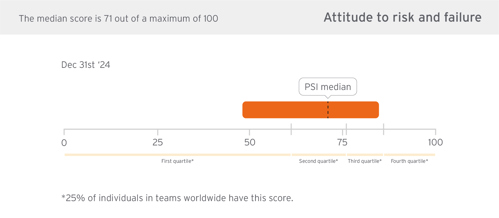Why This Domain Matters
In a competitive workplace, the ability to innovate, adapt, and respond to change is essential. And yet, innovation is impossible without risk. Failure is an unavoidable part of doing meaningful work. What distinguishes high-performing teams is not whether they fail - but how they respond when they do.
Attitude to Risk & Failure is one of the most critical domains for fostering innovation and psychological safety. As Amy C. Edmondson’s research shows, teams that feel safe to take risks and view failure as a learning opportunity are far more likely to experiment, challenge assumptions, and move the needle on performance.
By contrast, when psychological safety is low in this area, teams often default to playing it safe. People stay silent, avoid experimentation, and resist change. The result is stagnation, frustration, and missed opportunities for growth.
What the Score Means
In the Psychological Safety Index, the Attitude to Risk & Failure domain reveals how your team approaches uncertainty, experimentation, and mistakes.
A high score suggests:
-
People feel safe trying new approaches, even if they might fail
-
Team members openly discuss what didn’t work and why
-
Mistakes are treated as opportunities to reflect and learn
A low score may indicate:
-
Fear of making mistakes or being blamed for failure
-
Reluctance to try something new or suggest bold ideas
-
A culture of perfectionism that stifles experimentation
Global Benchmarks

From our global data set, Attitude to Risk & Failure consistently scores the lowest of the four domains. This trend holds across industries, regions, and organizational levels.
Many teams value safety and stability, but too often that safety comes at the cost of growth. Leaders often say they want innovation, but without creating the psychological conditions for risk-taking, that innovation can’t take root.
Key Mindsets and Behaviors
To improve the Attitude to Risk & Failure domain, leaders and teams need to shift both their beliefs and behaviors around what failure means.
Mindsets that support psychological safety in this domain:
-
Growth mindset: Failure is not an endpoint, but a necessary part of learning.
-
Curiosity over certainty: It’s more valuable to explore what could work than to be right all the time.
-
Resilience: Setbacks are temporary and can be used to build strength and insight.
Key behaviors to reinforce those mindsets:
-
Leaders model openness by sharing failures and lessons learned
-
Teams hold regular debriefs that focus on learning rather than blame
- Efforts are recognized, even if outcomes fall short
Red Flags to Watch For
Certain patterns can indicate low psychological safety in this area. Be on the lookout for:
-
People apologizing for or hiding mistakes
-
Little to no experimentation or iteration in the team’s work
-
“We don’t have time to get it wrong” becomes a common excuse
-
Mistakes are discussed behind closed doors instead of openly and constructively
These behaviors often come from fear - fear of judgment, job loss, or diminished status. If unaddressed, they create a brittle team culture where growth is limited.
Practical Steps to Improve This Domain
Improving your team’s attitude toward risk and failure doesn’t mean encouraging recklessness. It means creating space for thoughtful experimentation and honest reflection.
1. Model vulnerability as a leader
Talk openly about your own missteps and what you learned from them. This creates permission for others to do the same.
2. Hold “failure learning” sessions
When something doesn’t go as planned, create a routine to unpack it together. Focus on what you’ve learned and what might be done differently next time.
3. Celebrate the effort, not just the outcome
Recognize when someone takes initiative or tries something new, regardless of whether it succeeds. This shifts focus from performance to progress.
4. Encourage small, safe experiments
Not every risk needs to be big. Try running low-stakes experiments where the cost of failure is small but the learning is real.
5. Build reflection into team routines
After projects, ask questions like “What surprised us?” or “What would we do differently next time?” Reflection reinforces that learning is an expected part of the process.
Wondering how your team measures up in their Attitude to Risk & Failure?
We offer a simple and effective team assessment tool that provides anonymous insights into your team's psychological safety levels. Both an overall score as in the four domains. This invaluable assessment is the first step towards unlocking your team's full potential.



